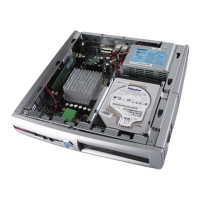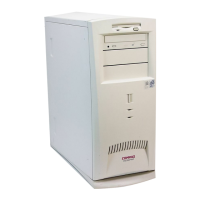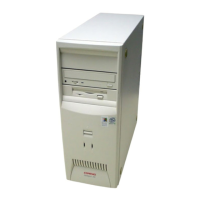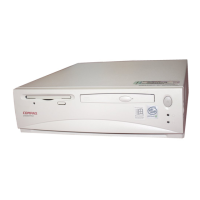Technical Reference Guide
7.1.2 POWER CONTROL
The power supply assembly is controlled digitally by the PS On signal (Figure 7-1). When PS On
is asserted, the Power Supply Assembly is activated and all voltage outputs are produced. When
PS On is de-asserted, the Power Supply Assembly is off and all voltages (except +3.3 AUX and
+5 AUX) are not generated. Note that the +3.3 AUX and +5 AUX voltages are always
produced as long as the system is connected to a live AC source.
7.1.2.1 Power Button
The PS On signal is typically controlled through the Power Button which, when pressed and
released, applies a negative (grounding) pulse to the power control logic. The resultant action of
pressing the power button depends on the state and mode of the system at that time and is
described as follows:
System State Pressed Power Button Results In:
Off Negative pulse, of which the falling edge results in power control logic asserting PS
On signal to Power Supply Assembly, which then initializes. ACPI four-second
counter is not active.
On, ACPI Disabled Negative pulse, of which the falling edge causes power control logic to de-assert the
PS On signal. ACPI four-second counter is not active.
On, ACPI Enabled Pressed and Released Under Four Seconds:
Negative pulse, of which the falling edge causes power control logic to
generate SMI-, set a bit in the SMI source register, set a bit for button status,
and start four-second counter. Software should clear the button status bit
within four seconds and the Suspend state is entered. If the status bit is
not cleared by software in four seconds PS On is de-asserted and the
power supply assembly shuts down (this operation is meant as a guard if
the OS is hung).
Pressed and Held At least Four Seconds Before Release:
If the button is held in for at least four seconds and then released, PS On is
negated, de-activating the power supply.
7.1.2.2 Power LED Indications
A dual-color LED is used to indicate system power status. The front panel (bezel) power LED
provides a visual indication of key system conditions listed as follows:
Power LED
Condition
Steady green Normal full-on operation (S0)
Blinking green @ 1 Hz Suspend mode (S1)
Blinking green @ 2 Hz Sleep (suspend to RAM) state (S3)
Blinking green @ .5 Hz Sleep (suspend to Disk) state (S4)
Steady red Processor not seated
Blinks red @ 2 Hz Power supply crowbar activated
Blinks red @ 1 Hz BIOS ROM error
Blinks red @ 4 Hz Thermal condition: processor has overheated and shut down
(later systems using PCA#s 011305, 011308, or 011311
power
done for this condition).
Compaq Deskpro and Evo Personal Computers
Featuring Intel Celeron and Pentium III Processors
Fifth Edition - March 2002
7-3
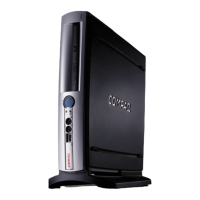
